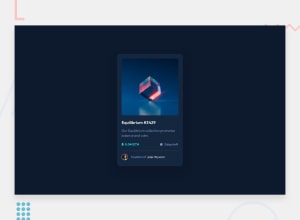
Design comparison
Solution retrospective
I found using the hoover efect extremely difficult I am unsure of the active version what is the difference between margin and padding
Community feedback
- @climb512Posted over 1 year ago
You did it!! Looks great! I see that you used a screenshot image of the "eye icon" rather than the .svg in the images folder, which is fine if you prefer how the .png looks. The main reason to prefer an .svg over a .png is that it will scale up without losing its sharpness, but that isn't an issue here.
Great job :)
Marked as helpful0 - @climb512Posted over 1 year ago
Looks good!
You've got the basics down, now let's tackle the positioning concepts that make the hover effects possible.
The hover effect on the main image is done in css by using "position" and "opacity".
So, first create an empty <div> the same size as the large image, center the "eye" icon inside of it, setting a cyan background and then, importantly, setting its opacity to 0. This makes it invisible. Then you use :hover on the <div> to change opacity to 1 when the mouse hovers over it. Something like this:HTML: <div class="image-group"> <img class="image__img" src="images/image-equilibrium.jpg" alt="NFT Equilibrium #3429"> <div class="image__overlay"> <img src="images/icon-view.svg" alt="eye icon" class="hover-eye"> </div> </div> CSS: .image-group { position: relative; } .image__overlay { position: absolute; top: 0; left: 0; width: 100%; // this means 100% of the containing element, the .image-group div height: 100%; // this means 100% of the containing element, the .image-group div background: hsla(178, 100%, 50%, 0.5); //cyan color opacity: 0; .image__overlay:hover { opacity: 1; }As for margin vs padding, you can search for info on the "box model" of css, and there are a million resources that explain it in detail. Basically, your "content", like, say, a picture or some text, sits at the center of your element (a <div>, a <p>, or whatever). This element can have padding, then possibly a border and finally margin around it, in that order, moving outwards from the center. Padding and margin can both be used to space out elements, but experimentation will show you that they are actually not the same. For instance, a background color will show up in the padding, but not in the margin. Please check out the "box model" for a full explanation.
I hope this helps! Keep coding!!
Marked as helpful0@beth1207Posted over 1 year agothis was an eye opener thanks a lot. I appreciate, hope you'll review the updated one.@climb512
0
Please log in to post a comment
Log in with GitHubJoin our Discord community
Join thousands of Frontend Mentor community members taking the challenges, sharing resources, helping each other, and chatting about all things front-end!
Join our Discord
